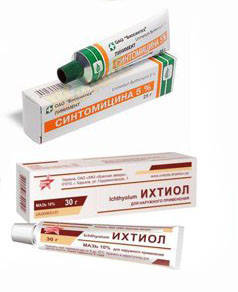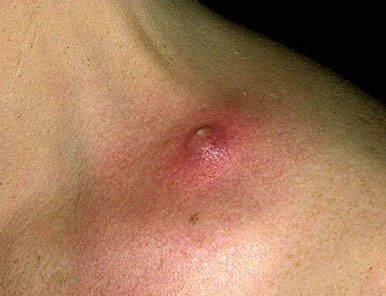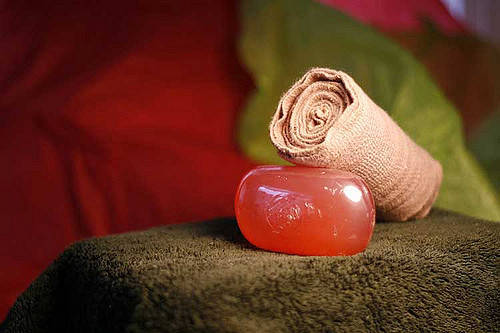How to effectively draw out pus from a boil
Boils, popularly called boils, are a problem that is familiar to many of us firsthand. These small (5-20 mm in diameter), but very painful inflammations always cause a lot of trouble. When a boil appears on the skin, you want to get rid of it as soon as possible. But it is important to do this without harming your health.
Before you start fighting inflammation, you need to understand what causes it and what it is.
A boil is the result of the activity of bacteria, usually Staphylococcus aureus, which is an inflammation of the hair follicle. A dense, painful lump appears on the skin. A purulent core forms in the center of the tumor. After full ripening, the boil opens and its contents come out. With proper disinfection and timely treatment, the wound heals quite quickly.
What treatment will make it easier to open a boil?
The process of boil formation can take quite a long time. At the first stage, a painful, reddened swelling appears, which gradually forms into a boil with purulent contents. Treatment should mainly be aimed at accelerating the maturation and opening of the boil.
Often, warming procedures are used for these purposes, such as a heating pad, a blue lamp, or a compress with heated sea salt. But the fact is that there is a danger of overheating the inflammation and causing the growth of the tumor and the spread of pus to nearby tissues.
To accelerate the maturation of the boil, pulling, antiseptic, and antimicrobial ointments are widely used. The list of such ointments is quite extensive, but the most popular among them are:
 1.Levomekol – antibiotic and immunostimulant;
1.Levomekol – antibiotic and immunostimulant;
2. Ichthyol ointment is an anesthetic and bactericidal agent;
3. Synthomycin ointment is an antibiotic that effectively draws pus from boils;
4. Vishnevsky ointment - a drug that stimulates the maturation and breakthrough of the abscess;
5. Tetracycline ointment is a broad-spectrum antibiotic.
Before using any of the listed ointments, you must carefully treat the skin around the inflammation with 3% hydrogen peroxide or medical alcohol. The ointment is applied to the boil and fixed with a bandage or plaster. The dressings are changed every few hours.
There are also many traditional medicine recipes that accelerate the ripening and opening of a boil.
You can use the pulp of aloe or Kalanchoe. Drop a few drops of iodine onto a fresh cut of a leaf, apply to the inflammation and secure with a bandage or plaster for 3-4 hours. Then replace with a new sheet. This method will help the formation of a purulent core and speed up the breakthrough of the boil.
Another fairly effective folk remedy for drawing out pus is soap shavings. Finely grated laundry soap is placed in a metal mug, poured with milk so that it covers the soap and boiled over low heat, stirring until dissolved. Apply the resulting mass onto gauze or a bandage folded several times and apply to the boil. The dressing is changed 2-3 times a day.
A fairly well-known way to get a boil to open is to apply baked onions to it. The onion head is baked in the oven in its skin until softened. Then it is cut into pieces, the cut is applied to the abscess and fixed with a bandage.
During the treatment process, it is possible to alternate any of the listed remedies.
Is it necessary to open a boil?

Doctors say that after a purulent core begins to form in the inflammation, the opening of the boil can no longer be avoided. And therefore, there are only two options for the development of events - either a spontaneous breakthrough of the abscess, or surgical removal of the boil in the clinic.
Unfortunately, there is a misconception that a boil is not very dangerous and can be dealt with at home as easily as a regular pimple, that is, simply squeezed out. It is precisely such actions that lead to serious complications.
Under no circumstances should you open a boil yourself! If the abscess does not spontaneously rupture, then you need to go to a clinic, where experienced doctors will select the appropriate treatment for each patient.
You should not delay your visit to the doctor, since the accumulated pus can grow and begin to spread throughout the body, affecting surrounding tissues and nearby organs.
How is surgical removal of a boil performed?
Removing a boil in a clinic is a quick procedure (about half an hour) and painless, since it is performed under local anesthesia.
During the operation, the doctor makes a small incision over the boil and cleans out the purulent contents. The resulting wound is thoroughly washed and filled with an antibacterial drug. After this, it is possible to install a drainage to remove the resulting pus. The final stage of the operation is the application of a sterile antibacterial dressing.
In some cases, a course of antibiotics may be required, prescribed to each patient individually.
After removal of the boil, the patient should not be bothered by severe pain at the site of the wound, rash, severe swelling of the skin or bleeding. If at least one of these signs appears, you should immediately go to the hospital.
In the vast majority of cases, if all the doctor’s instructions are followed, the wound will successfully heal within a couple of weeks and a small scar will form in its place.
What to do if the boil breaks out on its own
As already mentioned, the fight against boils comes down primarily to accelerating their opening, in order to ensure that the pus escapes outward and not into the tissue surrounding the boil.

When the boil has opened, it is necessary to carefully remove its contents and disinfect the wound. If you feel that the pus has not completely come out, you need to apply a compress with drawing ointment to the boil, and then repeat the procedure for cleaning the wound.
When the wound is completely clean, it is recommended to apply a healing ointment, for example, Levomekol. The ointment is applied under a sterile bandage and changed every few hours until complete healing.
After successfully fighting boils, it would be nice to think about how to protect your body from such a problem in the future. To do this, you need to follow a number of simple rules: do not neglect personal hygiene, eat right, avoid colds and promptly disinfect any scratches that arise.
Photo 4 via Flickr: Ivy Dawned (4).




